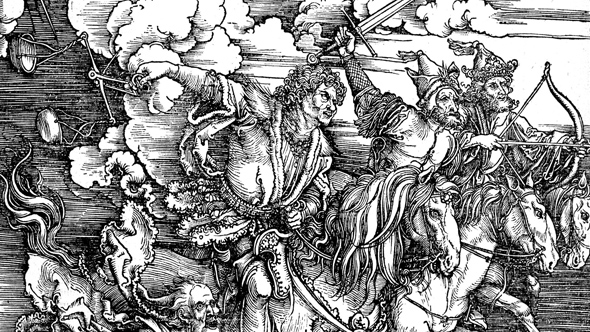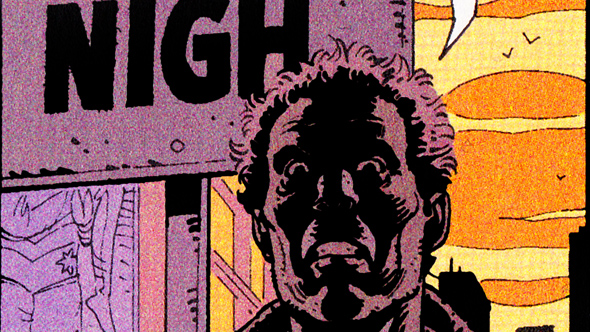
A Tupi-Guarani tribe seeking the ‘Land-without-Evil’, a Mughal Sultan quizzing a Catalan Jesuit about the Last Judgement, a German theologian yelling ‘omnia sunt communia!’; each in some way anticipated an impending finality to the world around them, an end of times. From the Americas, through Europe, to the Indian Ocean littoral, the long sixteenth century was peculiarly rife with artists, thinkers, states and social movements that constructed their politics around Apocalypse. What explains the prevalence of these apocalyptic expectations? Was there some connection between each instance? Might the common emphasis on the Apocalypse disclose some shared historical experience among these otherwise disparate communities?
The argument offered here is that Apocalypse and its associated ideas of catastrophe and salvation tend to arise ‘in a historical context in which one mode of production and life is being supplanted by another’. In the case of the sixteenth century, this involved the breakdown of agrarian modes and the emergence of a process of primitive accumulation that would mark the origins of capitalism.
Such themes are anticipated in Albrecht Dürer’s 1498 Four Horsemen of the Apocalypse, in which the four harbingers of reckoning furiously rout all before them. Straddling the horses of ‘pestilence’, ‘war’, ‘famine’, and ‘death’, each signifies the choke points of feudalism: the bubonic plague, internecine military competition, the vicissitudes of agrarian production, and demographic fluctuations. Meanwhile, a diabolical monster drags members of the ruling class into hell, representing and demonising the widespread rebellions that would attack the institutions of serfdom, empire and papacy from below. The extensive reproduction of Dürer’s Book of Revelations (there were 750 editions and commentaries from 1498-1650) suggests that his vision resonated throughout the sixteenth century, among the ruling and ruled classes alike, capturing the turmoil of a mode of production nearing its end.
The destruction of peasant life and subsequent reordering of social relationships was earth-shattering for many, generating in turn millennial hopes of a Final Judgement and salvation that informed rural rebellions and revolts. For Martin Luther, whose 95 theses would trigger the religious revolts of the Reformation, prophecies of the Last Days functioned as a critique of Catholic and princely excesses. The eschatology of ‘End Time’ and messianic prophecy was also central to movements such as the Anabaptists, who pushed the Reformation in more radical directions, by calling for the liberation of ‘The Elect’ – the common people – and annihilation of private property. Most notably, in the German town of Münster, Anabaptists ousted the clerico-aristocratic elite and set about constructing an autonomous ‘New Jerusalem’ based on absolute equality, polygamy, mutual aid and the communal ownership of land and goods.
But it is instructive to also look beyond Europe. In addition to Tupi-Guarani migrations, the millenarian Taki Unquy movement emerged in resistance to colonial penetration in South America. Advocating Pan-Andean revivalism, they prophesied that a rejection of Spanish customs – clothing, religion, tributes, and labour services – would revive local gods that were present in the mountains, water, animals and rocks. Consequently, the Spanish would be destroyed in a wave of pestilence and floods. The eschatological emphasis on the sources of communal rights such as land and water demonstrate that Taki Unquy – like their European contemporaries – expressed more than other-worldly aspirations. Apocalypse was imminent and terrestrial, an event in which the ‘living could participate’. In this respect, the economic and political aims of purging ruling classes and reasserting communal rights were seen as instrumental to – and functions of – apocalyptic hopes.
The social disorder created by these global movements confronted the ruling class as an existential threat – the coming of the Last Days. Dürer’s Apocalypse thus neatly encapsulated angst among the rich and powerful, helping to render explicable a world that was increasingly uncontrollable and unrecognisable. At the same time, images such as Dürer’s were summoned to articulate strategies for dealing with that world. Demons, monsters and witches – omens of cataclysm – would play a central role in the acts of colonisation, enclosure and plunder.
In the Americas, Franciscan millenarianism was central to the colonial project. The accidental discovery of the New World appeared symptomatic, an ‘Earthly paradise’ which offered colonisers the opportunity to construct a ‘really existing’ Garden of Eden. Here the conversion of indigenous populations appeared as ‘a spiritual challenge afforded by God’, and was regularly promoted by Spanish colonialists as the primary mission in the Americas. But undergirding this utopian project was something considerably more insidious since colonisers, belligerent or benevolent, saw the lack of Christianity as a marker of ‘savagery’ and ‘backwardness’ among local populations.
By formulating difference as absence, a hierarchy between the Spanish and indigenous communities was constructed that legitimised Spanish conquest and rule (a practice that prefigured ‘the civilising mission’ and ‘white man’s burden’). Insofar as movements such as the Taki Unquy and Tupi-Guarani resisted Spanish rule and conversion, they were seen as monstrous harbingers of a Satanic world. The demonisation of local populations led to the banning of local customs, destruction of idols and temples, and the hunting and mass slaughter of anyone who resisted – in short, what the Spanish called ‘just war’ (the logic remains today, now as ‘humanitarian intervention’). Stripped of their autonomy and removed from any communal access to the means of subsistence, indigenous workers were thus subordinated to the reproductive requirements of the colonial system.
Simultaneously in Europe, the ruling class saw among the multitude of landless peasants, vagrants, servants, pirates, women, migrants and resistance movements bearers of the Last Days – demons, monsters and witches. As symbols and agents of chaos, they represented a threat to a ruling class grasping for stability. The latter would eventually turn to terror and coercion in order to discipline the common people by enclosing land, dispossessing peasants, punishing vagrancy and burning women at the stake. Each practice was built on the demonisation of certain sections of society – vagrants as monsters, women as witches. Here, anxieties of a forthcoming Apocalypse conveyed and legitimised the ruling class strategies of separating people from land, and separating people from each other – that is, the destruction of the commons as a sphere of production and communality as a mode of life.
These processes would eventually prove constitutive of the creation of a class of people with no direct access to the means of subsistence, and with nothing to sell other than their labour-power – that is, the creation of the modern proletariat, and capitalism as such. And as many authors have noted, processes denoted by ‘primitive’ accumulation remain integral to the continuing reproduction of capitalism, be it via forced evictions, IMF-led structural adjustment, or ‘Shock and Awe’ military tactics. It is perhaps for this reason why millenarian movements continued to sporadically arise in the process of capitalism’s penetration into various communities in the seventeenth, eighteenth, nineteenth and twentieth centuries. It may also explain why secularised versions of the End Times still capture our imagination. Where destructive methods of dispossession and ‘creative’ systems of accumulation persistently intersect, where capital supplants living labour with dead labour, where these ‘moving contradictions’ trigger economic crises, wars, ecological catastrophes, demographic disasters, and mass immiseration, the Apocalypse abounds.
By Kerem Nisancioglu | @KeremBrulee









